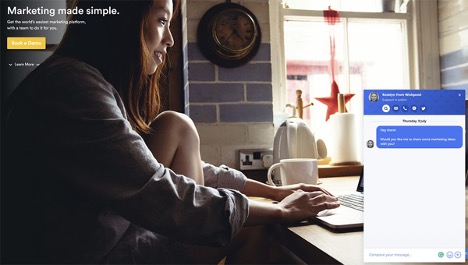
Those unfamiliar with the intricacies of business can take a reductionist view of how it functions.
What really matters, they’ll contend, is the core value proposition: the product or service that a business provides, and what it asks for in exchange.
Anything else is relatively insignificant.
If you offer the best product or the best prices, you’ll make sales — and if you don’t, then you won’t, because consumers only care about maximizing the return on their investment.
Anyone who’s spent any time thinking about it, of course, will understand just how ill-conceived this view is.
We don’t make rigorously-rational decisions about how we spend our money.
Is it utilitarian to spend markedly more to buy a product from a department store purely because the decor is nicer and you get treated like a VIP by the in-store assistant?
No, but it still happens.

Offering a good user experience, then, is extremely important.
If your site proves frustrating to use, even the most competitive value proposition will fall flat — and if a customer leaves with a positive experience of their transaction (even before they receive the product), they’ll be considerably more likely to return for more.
Most things we can buy are available from so many different stores at similar prices, after all.
It’s the UX that makes the difference.
Digging even deeper into the impact of UX, we need to highlight trust.
This is notable because trust is a key factor in eCommerce.
You can dazzle someone with a slick website and great prices, but if they don’t trust your site then they might not be willing to submit their payment details — and if they do, they might not want to return.
In this post, we’re going to look at four UX elements that will help you win customer trust.
4 UX Elements that win customer trust
1.Visual consistency
Presentation matters.
It’s actually one of the most important things in modern UX, mainly due to the incredible rise in standards that has stemmed from the heated competition in the design world and the release of template-led tools.
Many website platforms (particularly those in the eCommerce world) provide large ranges of such templates that can easily be adapted.
WordPress, the most popular CMS in the world, pairs one highly-adjustable default template (which updates with the times) with a vast repository of free or paid theme templates (easily running into the tens of thousands).
But even the most niche platform will have enough options to meet the average user’s needs — GoDaddy, for instance (which, yes, isn’t just a host), offers 15 free website templates and 4 marketing email templates.
Now that it’s possible to spool out something that looks great (albeit generic and flatly in line with current design trends), the only sensible explanations for a business site having inconsistent visuals are indifference or ignorance — and neither reflects well upon the business as a whole.
A brand that’s proud of its website and the work it does will always seek to brand it very clearly.
It’s akin to putting your name on a project on which you’re proud to have worked: leaving your name off would suggest that you don’t want to be associated with it, giving the impression that you’re not happy with the finished document.
And visual branding ranges from something as simple as a logo to something as overlooked as how you structure your articles.
In addition, though, you need to think about industry consistency.
Here’s what I mean: if all your most successful rivals position their visuals in a particular way, you might need to follow in their footsteps.
Maybe the best example I can think of is the well-established YouTube thumbnail formula of the video title on one side and a presenter gurning to the camera on the other.

You’ll see this everywhere on the site, across all different types of channels.
I saw that ecomm giant Shopify opened a learning channel during lockdown, and every thumbnail is exactly what you’d expect.
Is this boring? Somewhat, yes.
But is it effective?
The results certainly suggest that, which is why it’s utterly ubiquitous.
The takeaway is that you mustn’t be contrarian.
If you want to have a fresh visual style, do so, but ensure that you don’t stray too far from the norm.
2. Content quality
Website copywriting is frustratingly undervalued, possibly because its effects are subtle and hard to assess.
This is why you see so much flat copy on eCommerce sites.
Like the novices I made mention of during the intro, they think all that matters is simple value.
In actuality, the content on a business website will consistently influence how much the customer (or prospective customer) trusts the brand, and influence the conversions as a result.
More than in any other ways, content generates trust through two particular things: tone and clarity.
Getting your tone right involves walking the fine line between expressing a unique brand style and meeting reader expectations (as with visuals).
There might be a market for a luxury brand that adopts a more informal tone, for instance, but only to a certain extent: anything past a certain level of informality will seriously undermine the credibility of the company.

Above is a good example of the kind of formality that typically goes with a luxury brand.
This excerpt from a Rolex page regarding the complexities of watchmaking doesn’t focus on readability.
Instead, the point is to convey sophistication.
As for clarity, well, that’s something that really comes to the fore in content about your company and your products.
Trustworthy companies don’t have anything to hide, allowing them to be completely transparent about their greatest successes and their biggest failures.
In fact, opening up about failures is great for engendering trust because it shows humanity and humility.
3. Authentication strength
When I talk about authentication here, I talk about the protection of two areas in particular: user accounts, and provided financial details.
There have been enough horror stories about account details being leaked in recent years that people have every reason to be wary.
It isn’t advisable, of course, but they habitually reuse passwords — so having the details of one account leaked can lead to a lot of trouble for other accounts.
As for financial details, there are some who still don’t trust online businesses with their account details.
They like to keep their details secure instead of risking them getting out.
And while it’s much rarer for card details stored by a business to be accessed improperly, it’s still a real risk.
PayPal and other go-betweens offer protection, but even so: customers want reassurances.
Your task, then, is to make it as clear as possible from your text and your processes that your system is fully secure.
If you meet certain familiar standards, display the badges (or trust seals for schemes such as the Verified by Visa program detailed above).
Provide an FAQ section that explains in detail what you’ve done to combat fraud.
The more you show that you take these issues seriously, the more trustworthy you’ll seem.
4. Support accessibility
To be clear, I don’t mean this as an imperative: I’m not telling you to support accessibility (though of course you should, as websites should be as accessible as possible).
Instead, I’m saying that your UX design needs core elements of customer support to be accessible at all times, no matter where the customer may be on your site.
Customers lean towards trusting companies that find the time to help them and seem to care about making their lives easier.
Now imagine that you’re on a product page, you’re concerned about the return policy, and you’re eager to talk to someone about it.
Can you see where to do that? Is it immediately clear how you can get that support?

If it isn’t, and you can’t even find how to contact someone after a brief look, then you might well feel betrayed somehow.
The promise of a great buying experience, sadly undermined by apparent apathy on the part of the team behind the brand.
Instead, suppose that you instantly spot an animated cue at the bottom of the screen — a cue that’s clearly for live chat — or possibly even an automatically-opened chat window as pictured above.
That’s how easy it should be to find support.
Company contact details should be available on every page, whether in the footer, in the main navigation bar, or provided in a toggleable popup.
Knowing that they can always use your site without needing to worry about being left without assistance will certainly make your customers more inclined to trust you.
Winning customer trust means keeping their custom and building a powerful source of referrals, so it warrants being treated as a priority.
Focus on the UX elements we’ve looked at here and you’ll be able to make some meaningful progress.

